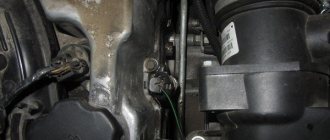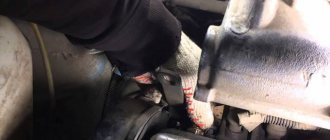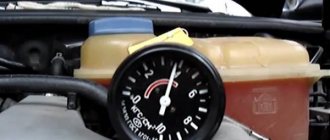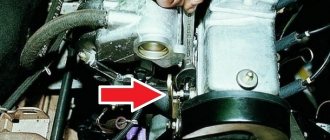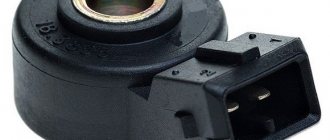Currently, there are more and more domestic cars, as Russia has begun to pay more attention to its cars and they have become noticeably prettier and more reliable. Lada Largus is one of the popular cars of the domestic automobile industry, and this car is captivating with its dimensions, 7 seats and, of course, its economical injection engine.
The injector on Largus is equipped with many sensors that must always be in good working order and clearly perform their functions. Failure of at least one of the sensors leads to serious problems in the operation of the engine or even the inability to start it.
In this article we will talk about injector sensors on Lada Largus cars, namely their purpose, location and signs of malfunction.
The engine control unit
To process readings from all sensors and control the engine, a special “brain”, an electronic engine control unit, is used. This part is used to take readings from sensors and, based on these readings, adjusts the fuel mixture, etc. A part rarely fails, but its main enemy is moisture; when water gets into the ECU, oxidation forms in it, which can cause short circuits and damage to the unit.
Oxygen sensor (OS) or lambda probe
The oxygen concentration sensor allows you to estimate the amount of remaining unburned fuel or oxygen in the exhaust gases. The signal is used by the control unit to maintain the optimal ratio of air to gasoline in the combustion chamber. Installed in the catalytic collector before the exhaust gas catalytic converter.
Refer to Oxygen Sensor Replacement and Testing.
Coolant temperature sensor
To adjust the fuel mixture depending on the coolant temperature and to automatically turn on the cooling fan in the Lada Largus car, a coolant temperature sensor (DTOZH) is used. The sensor is located near the thermostat and has a thermoelement inside it, which changes its resistance depending on the coolant temperature.
Signs of malfunction:
- The car does not start well when cold or hot;
- Increased fuel consumption;
- Black smoke from the chimney;
Speed sensor
A cable was previously used to determine the speed of a car, but in modern cars mechanics have faded into the background and now there are more and more electronics in cars. Speed in Largus is measured by a special speed sensor, which is located in the gearbox housing.
Signs of malfunction:
- The speedometer does not work;
- EUR does not work;
Crankshaft position sensor
To determine the top dead center of the piston in a certain cylinder, you need to know the position of the crankshaft, and a special DPKV sensor helps determine it. The sensor is installed near the crankshaft drive pulley and reads rotation readings from it. The sensor operates on the Hall effect.
Signs of malfunction:
- The engine does not start;
- There is no spark;
- ICE triples;
- Loss of dynamics and traction;
Intake system channel length control valve
AvtoVAZ began installing an intake manifold with variable geometry starting with the VAZ-21127 engine. This design allows for maximum torque at low speeds and maximum power at high speeds. The length of the intake manifold is adjusted (switching from one length to another) using a valve that is part of the engine management system.
See how to replace and test the sensor.
Knock sensor
In all engines, due to differences in fuel quality, detonations can occur that can damage the engine if they are not eliminated in time. To capture and eliminate detonations in the Largus engine, a knock sensor is used, which detects them and sends signals to the ECU, which changes the ignition timing to reduce vibrations in the engine. The sensor is installed on the cylinder block in the middle, near the oil dipstick.
Signs of malfunction:
- Knock of “fingers” under load;
- High consumption;
- Loss of power;
Clutch and brake sensors
Based on the signals from the clutch pedal position sensor and the brake light switch, the controller distinguishes between pressed and unpressed pedal positions. When the clutch pedal is pressed, the controller disables engine load regulation. Both sensors are located on the pedal assembly.
See "Replacing and Inspecting the Clutch Pedal Sensor" and "Replacing and Inspecting the Brake Pedal Sensor."
Some vehicle versions use an electronic throttle valve drive (E-gas). Let us remind you that in order to understand what errors are recorded in the ECU, you need to decipher them.
Categories of products that may be of interest to you based on the article “About Lada car sensors and engine management system”:
Phase sensor
Many modern cars are equipped with phased fuel injection, which reduces fuel consumption and increases engine efficiency. Phased injection allows for the implementation of a phase sensor (camshaft sensor). The DF reads readings from the rotation of the camshaft pulley and transmits the readings to the ECU. The sensor operates based on the Hall effect. Installed near the intake camshaft pulley.
Lada Largus (2019). Insufficient oil pressure (low oil pressure indicator light is on)
| List of possible faults | Diagnostics | Elimination methods |
| Low engine oil | According to the oil level indicator | Add oil |
| Oil filter is faulty | Replace the filter with a known good one. | Replace the faulty oil filter |
| The bolt securing the auxiliary drive pulley is loose | Check bolt tightness | Tighten the bolt to the specified torque |
| Clogged oil receiver mesh | Inspection | Clear the mesh |
| Skewed, clogged oil pump pressure relief valve or weakened valve spring | Inspection when disassembling the oil pump | Clean or replace the faulty relief valve. Replace the pump |
| Worn oil pump gears | Determined by measuring parts after disassembling the oil pump (at a service station) | Replace the oil pump |
| Excessive clearance between bearing shells and crankshaft journals | Determined by measuring parts after disassembling the oil pump (at a service station) | Replace worn liners. If necessary, replace or repair the crankshaft |
| Insufficient oil pressure sensor is faulty | We unscrew the low oil pressure sensor from the hole in the cylinder head and install a known-good sensor in its place. If the warning light goes out while the engine is running, the inverted sensor is faulty | Replace the faulty low oil pressure sensor |
Causes of drop in oil pressure
There is a light on the instrument panel that indicates emergency oil pressure in the engine. When it lights up, it is a clear sign of a problem. We'll tell you what to do if the oil pressure light comes on and how to fix the problem.
The oil check light can come on for two different reasons: either low oil pressure or low oil level. But what exactly does the oil light on the dashboard mean, only the operating instructions will help you find out. It will help us that, as a rule, budget cars do not have a low oil level indicator, but only a low oil pressure indicator.
Insufficient oil pressure
If the oil light comes on, this means insufficient oil pressure in the engine. As a rule, it lights up only for a few seconds and does not pose a great threat to the engine. For example, it can light up when the car rolls heavily during a turn or during a cold start in winter.
If the low oil pressure light comes on due to a low oil level, then this level, as a rule, is already critically low. First of all, when the oil pressure light comes on, check for the presence of engine oil. If the oil level is below normal, then this is the reason for this lamp to light up. This problem can be solved simply - you need to add oil to the required level. If the light goes out, we rejoice, and do not forget to add oil on time, otherwise this could result in serious problems.
If the oil pressure light is on, but the oil level on the dipstick is fine, then another reason why the indicator could light up is a failed oil pump. It does not do its job of ensuring sufficient oil circulation in the engine lubrication system.
In any case, if the oil pressure or low oil level light comes on, the car must be stopped immediately by pulling to the side of the road or to a safer place and turning off. Why do you need to stop right away? Because if the oil in the engine has depleted significantly, then the engine may stop and break down, with the prospect of very expensive repairs. Don't forget that oil is very important to keep your engine running. Without oil, the engine will fail very quickly - sometimes in just a few minutes of operation.
This situation also occurs when the engine oil is changed to new one. After the first start, the oil pressure light may come on. If the oil is of good quality, it should go out within 10-20 seconds. If it does not go out, the reason is a defective or non-functioning oil filter. It needs to be replaced with a new quality one.
Oil pressure sensor malfunction
The oil pressure at idle speed (at approximately 800 - 900 rpm) should not be less than 0.5 kgf/cm2. Sensors for measuring emergency oil pressure come with different response ranges: from 0.4 to 0.8 kgf/cm2. If a car is equipped with a sensor with a response value of 0.7 kgf/cm2, then even at 0.6 kgf/cm2 it will turn on a warning lamp, signaling a kind of emergency oil pressure in the engine. To understand whether the oil pressure sensor is to blame for the light coming on or not, you need to increase the crankshaft speed to 1000 rpm at idle. If the light goes out, then the oil pressure in the engine is normal. If not, then you need to contact specialists who will measure the oil pressure with a pressure gauge, connecting it instead of the sensor. Cleaning the sensor helps prevent false alarms. You need to unscrew it and thoroughly clean all the oil channels, because the cause of false alarms of the sensor may be due to blockages.
If the oil level is normal and the sensor is working
First of all, you need to check the oil dipstick and make sure that the oil level has not increased since the last check? Does the dipstick smell like gasoline? It is possible that gasoline or antifreeze is getting into the engine. It’s easy to check the presence of gasoline in the oil; you need to dip the dipstick in water and see if gasoline stains remain. If yes, then you need to contact a car service; the engine may need to be repaired. If there is a malfunction in the engine, which is caused by the oil pressure light coming on, it is easy to notice. Engine malfunctions are accompanied by loss of power, increased fuel consumption, and black or blue smoke coming out of the exhaust pipe.
If the oil level is normal, then there is no need to worry about a prolonged indication of low oil pressure, for example during a cold start. In winter, at low temperatures, this is an absolutely normal effect. After parking overnight, the oil drains from all lines and thickens. The pump needs a certain time to fill the lines and create the necessary pressure. Oil reaches the main and connecting rod journals earlier than the pressure sensor, so wear of engine parts is eliminated. If the oil pressure light does not go out for about 3 seconds, it is not dangerous.
What you can do yourself
Measuring engine oil pressure The problem of low oil pressure is greatly complicated by the relationship between lubricant consumption and level drop with the overall pressure in the system. In this case, a number of malfunctions can be eliminated independently.
If leaks are detected, the problem is quite easy to localize and solve. For example, oil leakage from under the oil filter can be eliminated by tightening or replacing it. The problem with the oil pressure sensor, through which lubricant flows, is solved in a similar way. The sensor is tightened or simply replaced with a new one. As for seal leaks, in this case you will need time, tools and skills. In this case, you can replace the front or rear crankshaft oil seal with your own hands in your garage with an inspection hole.
Oil leaks from under the valve cover or in the pan area can be eliminated by tightening fasteners, replacing rubber gaskets, and using special engine sealants. Violation of the geometry of the connecting planes or damage to the valve cover/pan will indicate the need to replace such parts.
If the coolant gets into the engine oil, then you can remove the cylinder head yourself and replace the head gasket, while following all the recommendations regarding the removal and subsequent re-covering of the cylinder head. An additional check of the mating planes will indicate whether the cylinder head needs to be ground. If cracks are found in the cylinder block or head, repairs are also possible. As for the oil pump, if this element wears out, it is better to immediately replace it with a new one. It is also not recommended to clean the oil receiver, that is, the part is completely changed. In the case where the problem in the lubrication system is not so obvious, and you have to repair the car yourself, then at the very beginning you should measure the oil pressure in the engine. To solve the problem, as well as taking into account an accurate understanding of where the oil pressure in the engine is measured and how it is done, additional equipment must be prepared in advance. Note that there is a ready-made device for measuring engine oil pressure available for free sale.
As an option, a universal oil pressure gauge will “Measure”. This device is quite affordable and comes with everything you need. You can also make a similar device with your own hands. To do this, you will need a suitable oil-resistant hose, pressure gauge and adapters.
To measure, a ready-made or home-made device is connected instead of an oil pressure sensor, after which the pressure readings on the pressure gauge are assessed. Please note that ordinary hoses cannot be used for self-production. The fact is that oil quickly corrodes rubber, after which the detached parts can get into the oil system.
The pressure in the lubrication system can drop for many reasons: - quality of the oil or loss of its properties; - leaks of oil seals, gaskets, seals; -oil “presses” out of the engine (pressure increases due to malfunctions of the crankcase ventilation system); - oil pump malfunctions, other breakdowns; -the power unit may be severely worn out, etc.
In some cases, drivers resort to using an additive to increase engine oil pressure. For example, XADO revitalizant. According to manufacturers, such an anti-smoke additive with revitalizant reduces oil consumption, allows the lubricant to maintain the required viscosity when heated to high temperatures, restores damaged crankshaft journals and liners, etc.
As practice shows, additives cannot be considered an effective solution to the problem of low pressure, but as a temporary measure for old worn-out engines, this method may be suitable. I would also like to draw your attention to the fact that the blinking oil pressure light does not always indicate problems with the internal combustion engine and its systems. It's rare, but it does happen that electrical problems arise. For this reason, the possibility of damage to electrical components, contacts, pressure sensor or the wiring itself should not be ruled out.
Finally, we would like to add that using only the recommended oil helps to avoid many problems with the oil system and engine. It is also necessary to select a lubricant taking into account individual operating conditions. The correct selection of viscosity index for the season (summer or winter oil) deserves no less attention.
Engine oil and filters must be changed correctly and done strictly according to regulations, since an increase in the service interval leads to severe contamination of the lubrication system. In this case, decomposition products and other deposits actively settle on the surfaces of parts and channel walls, clogging filters and the oil receiver mesh. Under such conditions, the oil pump may not provide the required pressure, causing oil starvation and significantly increasing engine wear.
Today, in the next article in the series “Crystal VAZs or typical breakdowns of domestic cars,” we will talk about the latest developments of the Volzhsky Automobile Plant: Lada Grante and Lada Largus. Let's talk about the history of the creation of these models, as well as their characteristic malfunctions.
Dear customers, in order to avoid errors when sending engine oil pressure sensor 8200671275, please indicate your car model and year of manufacture in the “Comment” line.
The Lada Largus engine is equipped with a distributed fuel injection system (a separate injector for each cylinder) with electronic control. The operating principles of the 1.6 (16V) and 1.6 (8V) engine control systems are almost the same. The main differences are the use of different ignition coils and different locations of individual system elements.
Various sensors are responsible for the operation of all systems of a modern Lada Largus car. They take readings and transmit them to the electronic engine control unit (ECU). If the sensor malfunctions, an error is stored in the memory, and in some cases a Check Engine error appears on the instrument panel.
Oil pressure sensor 8200671275 is connected to the engine control module. If the engine oil pressure drops below the limit value, the sensor contacts open. It is located at the bottom of the front wall of the cylinder block.
Rice. 1 Engine oil pressure sensor Lada Largus
Other articles of the product and its analogues in catalogues: 8200671275.
Lada Largus 4601.
Any breakdown is not the end of the world, but a completely solvable problem!
How to independently replace the oil pressure sensor (ICE) on a Lada Largus car.
Just COMPARE and BE SURE.
Don't forget to share the information you find with your friends and acquaintances, because they may also need it - just click one of the social networking buttons located above.
We replace the sensor when it fails. The sensor is screwed into a hole located in the lower part of the front wall of the cylinder block, under the spark plug of the 1st cylinder. By pressing the latch of the wire block...
...disconnect the block from the sensor.
Using a wrench or a high 22mm socket, unscrew the sensor.
The connection between the sensor and the cylinder block is sealed with an aluminum ring. When installing the sensor, screw it into the hole in the cylinder block by hand and tighten it with a tool. We connect the wire block to the sensor.
In Largus\Logan, due to the savings of factory managers/designers, there is no oil pressure control on the needle, only a lamp - yes/no.
This is one of the important parameters that warns the attentive driver about the beginning of the end of the engine or a change in modes, additional monitoring of the oil level. These parameters are: Drop in oil pressure Increase in coolant temperature Increase in oil temperature
The design of the Largus engine makes it possible to implement an indication of oil pressure in the cabin at minimal cost.
| pakhan74: |
| You know there won't be a delay. Renault decided to deceive everyone (it took me a long time to find a word), and on the new Logans they made a different algorithm for the oil pressure lamp, namely like this: Pavel, shouldn’t we create a topic about additional devices - oil pressure indicators and others. They ask themselves to come to Logan NEW. Largus won't be bothered either. Technically not difficult. oapv, as an excellent specialist auto electrician, will help with advice. I'll start here for now. The sensor of the Renault oil pressure warning lamp completely matches the seat with a similar VAZ sensor. Tested live. Oil pressure warning lamp sensor 2106-3829010 Applicability: VAZ cars Contact opening pressure: 0.2-0.6 kgf/cm2 Contact closure pressure: 0.6-0.2 kgf/cm2 Maximum current load on contacts: 0.5 A Fitting thread of fitting: M14x1.5 Electrical connection to the on-board network : Plug 6.35 Analogue MM120D Pressure sensor MM393A-3829010 (2103-38110300-01) Applicability: VAZ classic Operating pressure range: 0-8 kgf/cm2 Resistance at the sensor output: 290-320 Ohm Mounting thread of the fitting: M14x1.5 Electrical connection to the on-board network: socket 202612 OST 37.003.032-88 Oil pressure gauge VAZ A little primitive wiring and it's done. Renault oil pressure warning lamp sensor (standard for Largus/Logan) and VAZ tee, complete thread match. The tee is installed in the block in place of the standard sensor, and then to taste To fully confirm the matching of the threads, I assembled it like this: Those who have not only the desire, but also the funds, can use elegant cutlery. This indicator has 10 parameters with 4 interfaces, contains all the sensors, the price tag is 7 thousand. |
I have BC State installed there, the place is already taken.
| pakhan74: |
| I bought a mechanic, but the sellers themselves did not recommend it for permanent use. The hydraulic line may break at the wrong time. |
In our case (Largus/Logan) everything is electric from a VAZ 2103/06. Complete match of threads and no difficulties with electrical connections. The issue price is from 1000 rubles. for everything new.
| pakhan74: |
| I have BC State installed there, the place is already taken. |
I have a round Multitronics in the air duct hole, lucky.
| HR64: |
| pakhan74: |
| You know there won't be a delay. Renault decided to deceive everyone (it took me a long time to find a word), and on the new Logans they made a different algorithm for the oil pressure lamp, namely like this: Pavel, shouldn’t we create a topic about additional devices - oil pressure indicators and others. They ask themselves to come to Logan NEW. Largus won't be bothered either. Technically not difficult. oapv, as an excellent specialist auto electrician, will help with advice. I'll start here for now. The Renault oil pressure sensor for the lamp completely matches the seat with a similar VAZ sensor. Tested live. Oil pressure warning lamp sensor 2106-3829010 Applicability: VAZ cars Contact opening pressure: 0.2-0.6 kgf/cm2 Contact closure pressure: 0.6-0.2 kgf/cm2 Maximum current load on contacts: 0.5 A Fitting thread of fitting: M14x1.5 Electrical connection to the on-board network : Plug 6.35 Analogue MM120D Pressure sensor MM393A-3829010 (2103-38110300-01) Applicability: VAZ classic Operating pressure range: 0-8 kgf/cm2 Resistance at the sensor output: 290-320 Ohm Mounting thread of the fitting: M14x1.5 Electrical connection to the on-board network: socket 202612 OST 37.003.032-88 Oil pressure gauge VAZ |
From the experience of owning 06, as well as a gazelle with a similar display circuit, I can say that these devices are very inaccurate. In general, the pressure sensor on the gazelle failed in the first year, so I only drive with the emergency one. On the Zhiguli it seemed more or less, but it showed everything, from the weather on the moon to the direction of the wind, but the pressure was somehow not very good. The store told me about the mechanics; I was just thinking about purchasing a UAZ sensor with an indicator. I went to tractor and truck stores, found it and bought it for 600 rubles.
| mumrik75: |
| does the stately sensor do - on/off only? |
Emergency sensor yes, only on and off.
| pakhan74: |
| From the experience of owning 06, as well as a gazelle with a similar display circuit, I can say that these devices are very inaccurate |
This is true, direct mechanical indication is more reliable, except for oil leaks. I had additional VAZ instruments and sensors installed on many of my cars. I checked them with a mechanical pressure gauge, the accuracy is sufficient. Reliability is high, if not an obvious defect. Availability (at any stall). ease of installation/replacement, price.
| HR64: |
| Availability, in any stall, price. |
That's for sure.
Maybe I’ll make a VAZ one for a gazelle. The Gazelle barrel has a different resistance and simply cannot be attached to the shield. The price is the same as a VAZ sensor and indicator combined, but it is very unreliable. You'll have to put an indicator in the dashboard, since there's plenty of space. Does it seem to work at 0.6 atm?
Sergey, here are the technical data of the VAZ warning lamp sensor. Sensor (VAZ) 2106-3829010 Technical characteristics Operation limit (0.2-0) kgf/cm2. Voltage 12 V. Main manufacturer JSC AVTOPRIBOR
Connection diagram for additional lamp
In the case of Logan NEW with the sensor connected via the ECU, you need to understand the connection of the parallel lamp (LED) in more detail.
| HR64: |
| Sergey, here are the technical data of the VAZ warning lamp sensor. Sensor (VAZ) 2106-3829010 Technical characteristics Operation limit (0.2-0) kgf/cm2. Voltage 12 V. Main manufacturer JSC AVTOPRIBOR |
Connection diagram for additional lamp
By the way. You can set the value output not on the LED, but on the Arduino - so that it calculates the delay between the start of the engine operation and the moment the sensor is triggered. You won’t have to monitor the LED/lamp - the Arduino will display the time in tenths of seconds, maybe in hundredths - but it’s overkill.
I still plan to install an Arduino for the hour meter. During the life of the car, 60% of the EPROM resource will only be used up if you write the value every 5 minutes for 200 thousand km (5 thousand hours). This is probably what IVN-4 writes.
The oil pressure sensor is an indicator of sufficient oil supply to the upper part of the engine (cylinder head). Optimal oil pressure is one of the main factors in extending the service life of a VAZ engine.
As the pressure deteriorates, the lubrication of the rubbing parts deteriorates, which leads to their premature wear.
Operating the engine in the absence of oil pressure or when it is low is strictly prohibited.
The sensor is the same type for all front-wheel drive VAZ models; the process of checking, replacing and other actions is similar for all cars. A review of this sensor will be described using the Lada Priora as an example.
Lada Largus. Replacing the 1.6 (8V) engine low oil pressure indicator sensor
We replace the sensor when it fails.
The sensor is screwed into a hole located in the lower part of the front wall of the cylinder block, under the spark plug of the 1st cylinder.
By pressing the latch of the wire block...
...disconnect the block from the sensor.
Using a wrench or a high 22mm socket, unscrew the sensor.
The connection between the sensor and the cylinder block is sealed with an aluminum ring
When installing the sensor, screw it into the hole in the cylinder block by hand and tighten it using a tool. We connect the wire block to the sensor.
Video on the topic “Lada Largus. Replacing the 1.6 (8V) engine low oil pressure indicator sensor"
Lada 111 Why is the oil pressure light blinking? Fixing the breakdown. Repairing VAZ 21111 Oil pressure blinking! What is the reason? I’m sure it’s nothing terrible. from Auto overhaul Why is the handbrake light on the dashboard?
Source
Oil pressure sensor on Priora: purpose of the device
The correct name of the device is the oil pressure warning light sensor, which plays a very important role in the design of a car engine. To understand its purpose, you need to know the following:
- The oil in the engine system provides lubrication of all moving and rubbing parts. Moreover, these are not only elements of the CPG (cylinder-piston group), but also the gas distribution mechanism. If the oil pressure in the system decreases, which occurs when it leaks or runs out, the parts will not be lubricated, which will lead to their accelerated overheating and, as a result, failure.
- Motor oil is also a cooler, which removes heat from heating parts, thereby eliminating the possibility of overheating. The oil circulates through the engine system, due to which the heat exchange process occurs.
- Another important purpose of the oil is to remove contaminants in the form of metal dust and chips formed during the friction of parts. These contaminants, along with the oil, flow into the engine sump and accumulate in the filter.
To monitor the oil level in the engine, a special dipstick is provided. With its help, the driver can determine whether everything is in order with the lubrication system. And if a low amount of oil is detected on the dipstick, you should immediately replenish it to the optimal level and search for the reason for its decrease.
Checking the oil level in a car engine is extremely rare, and besides, it is impossible to detect a reduced amount while driving. Especially for such purposes, an indication is provided on the instrument panel in the form of a red oil can. It lights up after turning on the ignition. When starting the engine, when there is sufficient oil pressure in the system, the indication goes out. If the oiler lights up while driving, you should immediately stop and turn off the engine, thereby eliminating the possibility of it overheating and jamming.
A decrease in oil pressure in the system can occur for one of the following main reasons:
- the oil level in the system has dropped below the minimum level;
- The oil pressure sensor has failed;
- the wire that connects to the sensor is damaged;
- oil filter contamination;
- oil pump malfunction.
In any case, you can continue driving the car only after eliminating the cause of the breakdown. And in this material we will look at one of the main reasons why the oil can lights up on a Priora - failure of the oil pressure sensor.
Replacing the low oil pressure indicator sensor (16V) Lada Largus
Tools:
- Open-end wrench 22 mm
Parts and consumables:
- New low oil pressure warning sensor
We replace the sensor when it fails.
We carry out the work on an inspection ditch or overpass.
1. We remove the protection of the power unit.
3. The sensor is screwed into a hole located in the lower part of the front wall of the cylinder block.
4. Press the lock of the wire block.
5. Disconnect the wire block from the sensor connector.
6. Using a 22mm wrench, unscrew the sensor from the threaded hole in the cylinder block.
7. The connection between the sensor and the cylinder block is sealed with a soft metal washer.
8. When installing the sensor, screw it into the hole in the cylinder block by hand and tighten it using a tool. We connect the wire block to the sensor.
The article is missing:
- High-quality photos of repairs
Types of oil pressure sensors
The Priora uses an electronic oil pressure sensor, which is also called an emergency sensor. It monitors the oil pressure in the system, and if it decreases, it sends a signal to the instrument panel, causing the oil can indicator to light up. Such sensors are used on all cars and are mandatory.
They are no longer found on modern cars, but early versions of VAZ cars used mechanical sensors that displayed the pressure value using a dial indicator. This allowed the driver to determine whether everything was in order with his engine lubrication system.
This is interesting! Some car owners resort to installing an oil pressure indicator in the car to monitor the health of the oil pump and lubrication system. This is realized by installing a splitter in the hole where the pressure sensor is located, with which you can connect the sensor to the signal lamp and the hose to the dial indicator.
Where are the sensors located?
All modern Lada cars (Granta, Kalina, Priora, Vesta, Largus, Niva or Lada XRAY) are equipped with domestic VAZ engines. The location of the sensors on these motors is the same:
Elements of the electronic engine control system of the VAZ 11186/11189: 1* – controller; 2* – crankshaft position sensor; 3* – control oxygen concentration sensor; 4* – diagnostic block; 5* – diagnostic oxygen concentration sensor; 6 – throttle control unit; 7* – vehicle speed sensor; 8* – adsorber purge valve; 9* – gas pedal module; 10* – brake signal switch; 11* – clutch pedal position sensor; 12 – battery; 13 – mass air flow sensor; 14 – coolant temperature sensor; 15 – ignition coil; 16 – knock sensor; 17 – spark plugs; 18* – nozzles. *The item is not visible in the photo.
Location of ECM elements in the vehicle interior (for clarity, without dashboard): 1 – clutch pedal position sensor; 2 – brake signal switch; 3 – gas pedal module; 4 – controller.
The principle of operation of the electronic oil sensor on Priora
It is necessary to know the operating principle of such a device in order to be able to check its serviceability. The device operates quite simply. For this purpose, its design has a membrane 4 (Fig. below), which is connected to contacts 3.
The principle of operation of the pressure sensor on Priora
Now directly about the very principle of operation of the sensor:
- When the driver turns on the ignition, the oil pump does not build up oil pressure, so the indicator in the form of an oil can lights up on the dashboard. This happens due to the fact that contacts 3 are closed, and power is supplied to the signal lamp.
- When the engine starts, through the channel in the sensor, the oil acts on the membrane and pushes it upward, thereby disconnecting the contacts and breaking the circuit. The light goes out, and the driver can be sure that everything is in order with his lubrication system.
- The indicator on the instrument panel may light up when the engine is running in the following cases: if the pressure in the system drops (either due to low oil level or because of the oil pump) or due to a sensor failure (the membrane is jammed and does not disconnect the contacts).
Due to the simple operating principle of the device, such products are quite reliable. However, their service life also depends on quality, which is often unsatisfactory on oil pressure sensors for Priora.
Replacing the low oil pressure indicator sensor (8V) Lada Largus
Tools:
- Driver for socket attachment
- Knob attachment 22 mm
Parts and consumables:
- New low oil pressure warning sensor
We replace the sensor when it fails.
The sensor is screwed into a hole located in the lower part of the front wall of the cylinder block, under the spark plug of the 1st cylinder.
Replacing the low oil pressure warning sensor
1. By pressing the latch of the wire block, disconnect the block from the sensor.
2. Using a 22 mm wrench or a high socket, unscrew the sensor.
3. The connection between the sensor and the cylinder block is sealed with an aluminum ring.
4. When installing the sensor, screw it into the hole in the cylinder block by hand and tighten it using a tool. We connect the wire block to the sensor.
The article is missing:
- Photo of the instrument
- High-quality photos of repairs
Source
Signs of a malfunction of the oil pressure sensor on a Priora and methods for checking for serviceability
A characteristic sign of a malfunction of the device is the glow of an indication in the form of an oil can on the instrument panel when the engine is running. The indicator may also glow intermittently at high crankshaft speeds (over 2000 rpm), which also indicates a breakdown of the product. If you use a dipstick to check that the oil level is normal, then most likely the oil pressure sensor (oil pressure sensor) has failed. However, this can only be confirmed after checking it.
You can check and make sure that the cause of the glow of the oil can on the instrument panel is DDM by performing its test manipulations. The easiest way to check is to install a known-good sensor together with the standard product. And although it is inexpensive, few people are in a hurry to buy it, and in vain, because DDM on the Priora is one of the many diseases of the car.
To check the oil sensor on a Priora for serviceability, you need to remove it from the car. How to do this and where it is located is described in detail below. After removing the product, you need to assemble the circuit, as shown in the photo below.
From the thread side, compressed air from the compressor must be supplied into the hole. In this case, the lamp should go out, which indicates that the membrane is working properly. If the lamp does not light up when assembling the circuit, this may indicate that the membrane is jammed in the position with open contacts. You can verify this by testing the product with a multimeter.
Lada Largus. Replacing the low oil pressure indicator sensor for 1.6 (16V) engine
We replace the sensor when it fails.
We carry out the work on an inspection ditch or overpass.
We remove the power unit protection (see “Removing the power unit protection”).
The sensor is screwed into a hole located in the lower part of the front wall of the cylinder block.
By pressing the latch of the wire block...
...disconnect the wire block from the sensor connector.
Using a 22mm wrench, unscrew the sensor from the threaded hole in the cylinder block.
The connection between the sensor and the cylinder block is sealed with a soft metal washer. When installing the sensor, screw it into the hole in the cylinder block by hand and tighten it using a tool. We connect the wire block to the sensor.
Video on the topic “Lada Largus. Replacing the low oil pressure indicator sensor for 1.6 (16V) engine"
Lada 111 Why is the oil pressure light blinking? Fixing the breakdown. Repairing VAZ 21111 Oil pressure blinking!
What is the reason? I’m sure it’s nothing terrible. from Auto overhaul Why is the handbrake light on the dashboard Source
Where is the oil pressure sensor located on Priora
To check the DDM on a Priora or replace it, you need to understand its location. The oil pressure sensor on the Priora is located between the air filter housing and the oil filler cap. The photo below shows where the device is located on the Priora close up.
And its location is far away.
It is located in an open area and access to it is unlimited, which has a positive effect on the process of removal, inspection and replacement.
Replacing the low oil pressure indicator sensor (8V) Lada Largus
Tools:
- Driver for socket attachment
- Knob attachment 22 mm
Parts and consumables:
- New low oil pressure warning sensor
We replace the sensor when it fails.
The sensor is screwed into a hole located in the lower part of the front wall of the cylinder block, under the spark plug of the 1st cylinder.
Replacing the low oil pressure warning sensor
1. By pressing the latch of the wire block, disconnect the block from the sensor.
2. Using a 22 mm wrench or a high socket, unscrew the sensor.
3. The connection between the sensor and the cylinder block is sealed with an aluminum ring.
4. When installing the sensor, screw it into the hole in the cylinder block by hand and tighten it using a tool. We connect the wire block to the sensor.
The article is missing:
- Photo of the instrument
- High-quality photos of repairs
Source
Self-replacement of the sensor on Lada Priora
Replacing the DDM is carried out according to the instructions below.
- Remove the air filter and decorative engine cover.
- Squeeze the connector.
- Remove the terminal block.
- Unscrew the oil pressure sensor.
- Remove the sensor.
- Install a new DDM.
- Install everything in reverse order.
- Check the operation of the oil pressure level emergency indication system.
Mass air flow sensor (MAF)
This important sensor is located behind the engine air filter. It is also called an air flow meter. Its purpose is to estimate the amount of air entering the car engine. Based on the information received from the sensor, the electronic control unit (ECU) calculates the required amount of fuel to maintain the stoichiometric fuel-to-air ratio for the given engine operating conditions.
See “How to check the mass air flow sensor on LADA cars”
Accessories
Tire pressure monitoring sensors can be installed on any LADA model without exception. In our selection of products from aliexpress you will find:
- TPMS with external sensors (screwed onto a nipple instead of caps) (price RUR 2,554)
- TPMS with internal sensors (mounted inside the wheel) (price RUR 2,692)
- Indicator caps 2.0 Bar (price 120 RUR)
- Indicator caps 2.2 Bar (price 65 RUR)
- Indicator caps 2.4 Bar (price 98 RUR)
Do you use a tire pressure monitoring system on your LADA?
Source
Purchase and installation of TPMS ZEEPIN C260 (Tire Pressure Monitoring System).
When I first saw the Lada Largus, I immediately decided for myself: I will have it.
So I bought and installed a TPMS (Tire Pressure Monitoring System)!
As I recently wrote in a parallel thread Useful for us from AliExpress and similar sites!, I ordered a TPMS (Tire Pressure Monitoring System) for TRIFON.
Let's begin. Looking at the system data (TPMS) on AliExpress, for the most part, they had an indication block for a panel arrangement (lying down), and large dimensions, while the location of the solar panel was on top of this block. Which didn't suit me very much. Therefore, I was looking for an alternative, albeit more expensive, but with a mount on the windshield and with small dimensions. It was also initially decided to purchase a system with external sensors. Because I have 2 sets of wheels with tires and if I used internal sensors I would have to leave some set without them and in the summer or winter season I would have to be left without monitoring.
After spending several hours of searching, several options were found. Next, we studied the characteristics, appearance, method of fastening them, reviews from customers who had already purchased these models and managed to use them.
After a couple of days of “studying”, I only had one option left, which I bought and installed today.
And so, a review of the purchased tire pressure monitoring system TPMS ZEEPIN C260.
At the time of purchase, the cost of this system with external sensors was
$27. The same system but with internal sensors
At the top there is an instruction (there is no Russian language, but it is not needed), where on the front page there is a diagram for connecting the sensors!
Further. The indicator block itself is contained in perforated foam rubber and white cellophane.
On the right there is a micro USB port for charging:
On top there are 3 control and setting buttons:
And here is the solar cell itself, with tape on the sides for attaching to the windshield:
Further, under the layer of foam rubber there are: 4 sensors, a key for disassembling the sensors, a spare CR1632 battery for the sensor and a bag with lock nuts and a wrench for tightening them:
The key for disassembling the sensor is divided into 2 parts. The right part is for the top of the sensor, the left part is for the part that is screwed onto the fitting. And the sensor unwinds into 2 parts.
I'm starting to install the sensors on the fittings. This is probably the most difficult procedure.
I screw the required sensor onto the front left wheel, according to the diagram:
And with the key (from the kit) I check the sensor:
Well, I install the remaining sensors on the remaining wheels.

